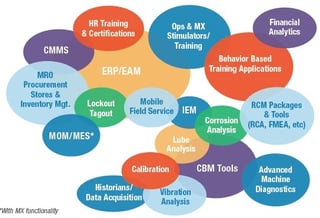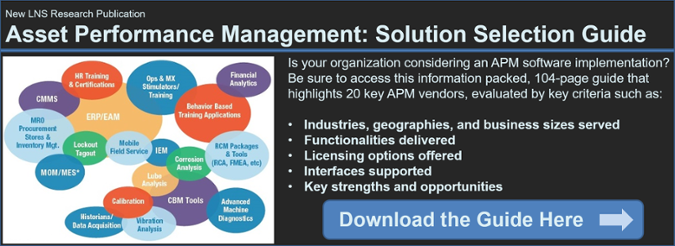 Asset performance management (APM) has become one of the most talked about practice areas in the industrial sector. Every user group meeting in the automation sector that LNS Research analysts have attended recently are talking about reliability, APM, and the Industrial Internet of Things (IIoT) as the way to drive operational excellence (OpEx).
Asset performance management (APM) has become one of the most talked about practice areas in the industrial sector. Every user group meeting in the automation sector that LNS Research analysts have attended recently are talking about reliability, APM, and the Industrial Internet of Things (IIoT) as the way to drive operational excellence (OpEx).
We certainly agree with them in that for well over a year now we have been talking about how APM is emerging as one of the key areas that demonstrates the value of mobility, the IIoT, cloud and Big Data and associated predictive analytics by driving hard-dollar benefits. We have also cautioned users on how they should architect their APM solutions portfolio.
As LNS Research defines it, APM is a broad category of solutions. These solutions are focused on all of the activities associated with keeping a production asset operating at its designed performance level to deliver value. This means APM starts with the acquisition about the assets performance and condition. APM includes the activities associated with supporting that asset, such as labor and spare parts management associated with enterprise asset management (EAM) or computerized maintenance management systems (CMMS’s). Of course not every solution provider can provide all of the capabilities every end user is looking for. Many times end users are making the wrong decisions about what solutions from which providers to use. It is critical to not only achieving the objectives of your APM program. but doing so affordably. Selecting the wrong combination of solutions can lead to overspending on technology, or even worse, overspending and worsening performance.
APM Options Offer a Lot of Overlap
The figure above illustrates just some of solutions that provide APM functionality. Some, such as Manufacturing Operation Management (MOM) applications may include some APM functionality related to maintenance work scheduling even though not every MOM application does. Likewise some condition-based maintenance (CBM) applications can operate with a wide range of information. All the while others are more focused such as looking only at vibration related data.
In some cases the vendor is very specialized since the domain expertise and knowledge is highly specialized, and the market is not large enough to attract significant competition. However, as cloud becomes far more prevalent, it becomes more configurable and easier to use. This is especially for dealing with Big Data and the predictive analytics tools. Vendors in the enterprise applications space are providing functionality that was once only available from specialized vendors. In addition, they are allowing users to self deploy the tools, and use social networking to refine their use of the technology instead of investing in dedicated and expensive services from specialists. Against this unfolding landscape, there is an ever increasing amount of functional overlap among the solutions.
How Many Times Has Your Business Bought The Same Functionality?
With all of the overlapping application functionality, it is inevitable that many businesses have often paid for the same functionality multiple times. It is not uncommon to have asset registers in the MOM, APM, EAM, and even ERP application portfolio. If there are specialized applications or maintenance programs, it is conceivable that assets could reside in as many as five or six registries. Besides that in many cases the functionality has actually been bought multiple times the bigger issue is that conflicting and overlapping applications can actually create a situation that inhibits good APM instead of fostering it.
This happens when different departments or staff uses different applications to deal with the same assets. It is not uncommon for maintenance staff to use an EAM application to document their interaction with an asset. Business staff will likely use an ERP application, operations might use their MOM solution, while contractors or specialized maintenance technicians use point solutions from specialized solution providers. The worst case scenario is when all these groups using different tools and looking at different data are trying to solve the same problem – usually diagnosing and fixing a reliability issue. This is why a manufacturers and asset intensive industries need their. When doing so and when selecting which solutions, you will need to deploy to round out your APM portfolio. You need to understand the specific capabilities of the vendors you are considering. Understanding where the overlap is, or may be in the future is the first step in avoiding conflicts.
Not Every Solution Provider Has What Your Business Needs
Besides the functionality issues already mentioned, there are other factors that should impact your choice of APM solutions providers. Factors such as geographic support capabilities, industry specific experience, and the vendors’ support of various sized businesses also should factor into your decision. When trying to decide which solutions are compatible with the architecture you have established, it is important to know licensing models, development platforms, and what interfacing technologies and standards are supported.
Understand the capabilities of twenty of the leading vendors in the APM space by downloading our APM Solutions Section Guide. The guide contains comparison charts for the factors listed above and the detailed profiles of the twenty vendors ranging from automation companies, to enterprise software providers and includes many specialized APM solutions as well.